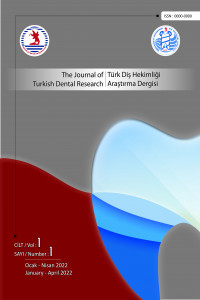Dens İnvajinatus ile Birlikte Görülen Bifasiyal Talon Tüberkülü: Bir Olgu Sunumu
Talon tüberkülü, dişin nadir gelişimsel anomalilerindendir.
Kartal pençesine benzediği için bu isim verilmiştir. Talon
tüberkülü genellikle kesici dişlerin palatinal yüzlerinde yer alır.
Bilateral ve bifasiyal olarak görülmeleri son derece nadirdir.
Talon tüberküllerinin etiyolojisi bilinmemekle beraber
multifaktoriyel olarak genetik ve çevresel etkenlerin
birleşiminden etkilendiği, gelişimsel olarak mine organının
dışa katlanması veya dental laminanın fazla üretkenliği sonucu
oluştuğu düşünülmektedir.
Dens invajinatus, dişin gelişimi esnasında mine ve dentin
organının dental papilla içerisine katlanmasından kaynaklanan
bir dental anomalidir. Bu olgu sunumunda bilateral talon
tüberkülü ve aynı dişte dens invajinatus ile birlikte görülen
bifasiyal talon tüberkülü vakası rapor edilmiştir.
Anahtar Kelimeler:
Dental anomali, talon tüberkülü, dens invajinatus
Bifacial Talon Cusp Presenting with Dens Invaginatus: A Case Report
Talon cusp is an uncommon odontogenic anomaly. Due
to its resemblance to an eagle’s talon, it was named as “talon
cusp”. Talon cusps occur most commonly on palatal surfaces
of permanent incisors. Bilateral and bifacial talon cusp is an
extremely rare occurrence.
The etiology of talon cusps remains unknown, though it
is thought to be a combination of genetic and environmental
factors, developmentally result of an outfolding of the enamel
organ or hyperproductivity of the dental lamina.
Dens invaginatus is a developmental anomaly which is
formed byfolding the enamel-dental organ through the pulp
chamber during the teeth development. In this case, bilateral
talon tubercle and bifacial talon tubercle with dens invaginatus
in the same tooth was reported.
Keywords:
Dental anomaly, talon cusp, dens invaginatus,
___
- White S C, Pharoah M J. Oral radiology principles and interpretation. 7th ed. St Louis: Mosby, 2014.
- Jowharji N, Noonan R G, Tylka J A: An unusual case of dental anomaly. A “facial” talon cusp. J Dent Child 1992; 59: 156-158.
- Gotoh T, Kawahara K, Imai K, et al. Clinical and radiographic study of dens invaginatus. Oral Surg 1979; 48: 88-91.
- Mehta V, Chowdhry A, Kapoor P. Bilateral talon cusp in permanent maxillary lateral incisors: A case report, clinico-pathological review and proposal of an integrated classification. J Oral Maxillofac Pathol. 2022 Jan-Mar;26(1):93-97.
- Dunn W J. Unusual case of labial and lingual talon cusps. Mil Med 2004;169: 108–110.
- Abbott P V. Labial and palatal “talon cusps” on the same tooth: A case report. Oral Surg Oral Med Oral Pathol Oral Radiol Endod 1998; 85: 726–730.
- Topaloğlu Ak A, Eden E, Ertuğrul F, Sütekin E. Supernumerary primary tooth with facial and palatal talon cusps: a case report. J Dent Child (Chic). 2008;75(3):309-12
- Guven Y, Kasimoglu Y, Tuna EB, Gencay K, Aktoren O. Prevalence and characteristics of talon cusps in Turkish population. Dent Res J (Isfahan) 2016;13:145–50.
- Hattab F N, Yassin O M, Al-Nimri K S. Talon cusp in the permanent dentition associated with other dental anomalies: Review of literature and reports of seven cases. J Dent Child 1996;63:368–376.
- Mallineni SK, Panampally GK, Chen Y, Tian T. Mandibular talon cusps: A systematic review and data analysis. J Clin Exp Dent. 2014;6:e408–13.
- Chek M. A clinical report on partial pulpotomy and capping with calcium hydroxide in permanent incisors with complicated crown fracture. J Endod 1978; 4: 232-237.
- Ghosh S, Dhungel S, Subedi B, Pradhan S. Cooccurrence of Talon’s Cusp with Dens Invaginatus in the Maxillary Lateral Incisor: A Case Report with Review of Literature. Case Rep Dent. 2022 Feb 22;2022:9165574.
- Colak H, Yilmaz C, Keklik H, Colak T. Talon cusps occurring concurrently with dens invaginatus on a permanent maxillary lateral incisor: a case report and literature review. Gen Dent. 2014;62(3):e14-8.
- Siraci E, Cem Güngör H, Taner B et.al. Buccal and palatal talon cusps with pulp extensions on a supernumerary primary tooth. Dentomaxillofac Radiol 2006; 35: 469–472.
- Başlangıç: 2022
- Yayıncı: Ondokuz Mayıs Üniversitesi
Sayıdaki Diğer Makaleler
Merve KÜÇÜKOGLU ÇOLAK, Murat İnanç CENGİZ
DİŞ HEKİMLİĞİ PRATİĞİNDE SIK KARŞILAŞILAN MAKSİLLER SİNÜSLERİN ENFLAMATUAR HASTALIKLARI: DERLEME
Rümeysa ŞENDİŞÇİ, Selmi YILMAZ
Dens İnvajinatus ile Birlikte Görülen Bifasiyal Talon Tüberkülü: Bir Olgu Sunumu
COVID-19 Pandemisinin Ağız, Diş ve Çene Cerrahisi Kliniğine Etkileri
Diş Çürüğünün Teşhisi ve Bu Amaçla Kullanılan Güncel Yöntemler
